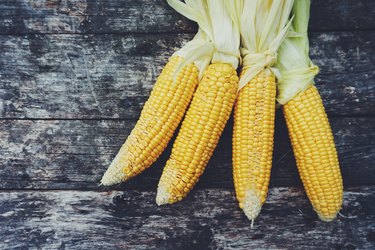
Everyone knows that fresh sweet corn is delicious, and many people also realize that corn, in various forms, has become a widely-used addition to prepared products — from breakfast cereal to ketchup. Hominy, however, is a specific product made from dried field corn through a special process. It can then be eaten on its own or ground to be used in making such staples as corn masa and grits.
How Types of Hominy Are Made
Video of the Day
The difference between hominy and corn has to do with the methods of preparation. Basically, all types of hominy consist of dried grain corn kernels that have been soaked in a hot alkaline solution and then thoroughly rinsed. This process makes the corn kernels puff up and renders the hulls easily removable. The hominy may be simmered until further softened, if desired. It can be eaten as-is or ground while either wet or dry.
Video of the Day
The type of alkaline solution and the variety of grain corn used are the determining factors in taste and consistency. The ancient people of the Mayan and Olmec civilizations in Mexico and Central America invented the process of using hydrated lime to make the alkaline solution. This process results in the corn's nutritious niacin content becoming available for the human digestive tract to absorb. Lime-treated hominy also contains a good dose of calcium.
Home cooks can still use this method with calcium hydroxide, known as pickling lime, which is widely available in supermarkets with large Mexican food sections. Be aware, though, that this substance is somewhat caustic and should be used with care. Look up the directions for this process and follow carefully. Mother Earth News, for example, provides a guide for making hominy at home.
Modern-day, commercially produced hominy uses lye instead of lime to provide the alkaline element. Here, too, indigenous people paved the way; the Hopi, Iroquois, Hidatsa and other tribes of the Great Plains and the Southwest extracted lye from wood ash, and European settlers copied the practice.
Hominy in the Supermarket
For the best, high-quality types of hominy, look either in your supermarket's Mexican food aisle or at your local Mexican foods market. You can find it either canned and ready to use or dried, in which case you can prepare it as you would prepare dried beans (i.e., soaking, then cooking them). The canned hominy is just as tasty and much less labor-intensive than dried, so go for it.
Canned hominy has a distinct, slightly sweet corn taste that does not dissipate when added to soups, stews or casseroles. It also acts as something of a thickening agent and is a staple in such Mexican soups as pork-and-chile-based posole and hearty, spicy menudo.
Hominy 2.0: Grits and Masa Harina
Grits are popular either by themselves or as an accompaniment to meals in the United States, particularly in the South. They're essentially dried hominy that has been grated — finely to coarsely — into a nubby, "gritty" substance that can be absorbed in simmering liquid (rather like rice) until it becomes creamy. The ratio of grits to liquid is about a cup of grits to 4 cups of liquid, with a simmering time of about 25–30 minutes. Instant grits are also available in many supermarkets, and they take just a few minutes to cook.
Southerners (and others!) enjoy grits as a breakfast dish, usually with a pat of butter on top. They also make a good side dish for dinner — and create a nice change from potatoes or bread. As a main dish, shrimp and grits reign supreme in many Southern kitchens and are becoming a favorite in other regions as well.
Masa harina is a long-time mainstay of Mexican cookery, used to make fresh tortillas, gorditas and other culinary staples. It, too, is produced from hominy. The dried hominy is put through a fine-grade grinder, which turns it into a kind of flour. In fact, masa harina is often referred to as "corn flour." All that's needed is water to make the corn dough required for authentic tortillas.